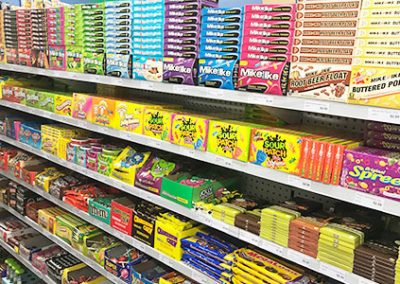Top Guidelines Of I Luv Candi
Wiki Article
Get This Report on I Luv Candi
Table of ContentsI Luv Candi Things To Know Before You Get ThisI Luv Candi Fundamentals ExplainedExcitement About I Luv CandiAll about I Luv CandiSome Known Incorrect Statements About I Luv Candi
You can also approximate your very own revenue by using various presumptions with our economic strategy for a sweet store. Typical regular monthly income: $2,000 This type of candy store is commonly a little, family-run company, possibly known to locals but not bring in great deals of vacationers or passersby. The shop may offer a selection of usual sweets and a few homemade treats.
The shop does not normally bring unusual or expensive items, concentrating instead on inexpensive deals with in order to keep routine sales. Assuming an average investing of $5 per client and around 400 customers each month, the regular monthly income for this sweet shop would be about. Typical monthly earnings: $20,000 This candy store take advantage of its tactical area in a hectic urban location, attracting a multitude of clients searching for sweet extravagances as they shop.

Along with its varied candy selection, this shop might additionally offer related items like gift baskets, sweet bouquets, and novelty products, offering numerous income streams. The store's place requires a greater budget for rental fee and staffing however leads to higher sales quantity. With an estimated ordinary costs of $10 per consumer and regarding 2,000 customers monthly, this store might produce.
I Luv Candi for Dummies
Found in a significant city and traveler location, it's a huge establishment, usually spread over numerous floors and potentially component of a national or global chain. The shop provides an enormous selection of candies, including special and limited-edition things, and goods like top quality apparel and accessories. It's not just a shop; it's a location.The functional prices for this kind of store are substantial due to the location, dimension, staff, and includes provided. Assuming an average acquisition of $20 per consumer and around 2,500 clients per month, this flagship store can accomplish.
Classification Examples of Expenditures Ordinary Regular Monthly Cost (Range in $) Tips to Lower Costs Rent and Utilities Shop lease, electrical energy, water, gas $1,500 - $3,500 Think about a smaller area, discuss rent, and make use of energy-efficient illumination and appliances. Supply Sweet, snacks, product packaging materials $2,000 - $5,000 Optimize supply administration to reduce waste and track preferred products to avoid overstocking.
Not known Facts About I Luv Candi
Advertising And Marketing and Marketing Printed products, online advertisements, promos $500 - $1,500 Focus on economical electronic advertising and make use of social media sites platforms free of cost promo. Insurance coverage Service liability insurance $100 - $300 Search for affordable insurance rates and take into consideration bundling policies. Devices and Upkeep Cash money registers, display shelves, fixings $200 - $600 Buy used equipment when possible and carry out routine upkeep to expand tools lifespan.
This suggests that the sweet shop has actually gotten to a factor where it covers all its dealt with expenditures and begins creating revenue, we call it the breakeven factor. Take into consideration an instance of a sweet shop where the month-to-month set expenses commonly total up to about $10,000. A harsh quote for the breakeven point of a candy store, would after that be about (considering that it's the overall fixed expense to cover), or offering in between with a price variety of $2 to $3.33 per unit.
I Luv Candi Fundamentals Explained
A big, well-located candy shop would undoubtedly have a higher breakeven factor than a little shop that does not need much earnings to cover their go to my blog costs. Curious regarding the success of your candy shop? Experiment with our straightforward financial strategy crafted for sweet-shop. Simply input your very own assumptions, and it will certainly help you compute the amount you require to earn in order to run a profitable service - spice heaven.An additional threat is competitors from various other candy stores or bigger stores who may supply a wider range of items at reduced prices (https://iluvcandiau.wordpress.com/2024/03/28/welcome-to-i-luv-candi/). Seasonal variations sought after, like a decrease in sales after holidays, can additionally affect productivity. Furthermore, changing customer choices for healthier snacks or nutritional limitations can minimize the appeal of traditional candies
Last but not least, economic slumps that reduce consumer investing can affect sweet-shop sales and earnings, making it important for candy shops to handle their expenses and adapt to transforming market conditions to stay rewarding. These risks are usually consisted of in the SWOT analysis for a sweet-shop. Gross margins and web margins are crucial indications made use of to gauge the success of a candy store service.
Not known Facts About I Luv Candi
Basically, it's the earnings staying after deducting prices straight related to the sweet stock, such as purchase prices from vendors, production prices (if the candies are homemade), and staff incomes for those involved in manufacturing or sales. https://i-luv-candi.jimdosite.com/. Net margin, conversely, consider all the expenditures the sweet-shop sustains, consisting of indirect expenses like administrative expenses, advertising and marketing, lease, and taxes
Sweet stores usually have an average gross margin.For circumstances, if your candy store gains $15,000 per month, your gross profit would certainly be roughly 60% x $15,000 = $9,000. Think about a sweet store that offered 1,000 sweet bars, with each bar priced at $2, making the complete revenue $2,000.
Report this wiki page